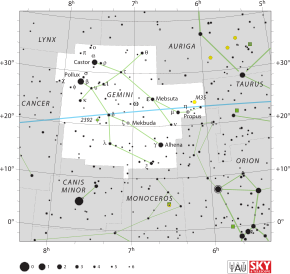
Back Tweeling (sterrebeeld) Afrikaans Cheminis (constelación) AN التوأمان (كوكبة) Arabic چيميناى (كوكبه) ARZ Xéminis AST Əkizlər (bürc) Azerbaijani Игеҙәктәр (йондоҙлоҡ) Bashkir Gemini BAN Nituna BBC Gemini (constellation) BCL
| Constellation | |
 | |
| Abbreviation | Gem |
|---|---|
| Genitive | Geminorum |
| Pronunciation | /ˈdʒɛmɪnaɪ/ JEM-in-eye genitive /ˌdʒɛmɪˈnɔːrəm/ JEM-in-OR-əm |
| Symbolism | the Twins, Castor and Pollux |
| Right ascension | 7h |
| Declination | +20° |
| Quadrant | NQ2 |
| Area | 514 sq. deg. (30th) |
| Main stars | 8, 17 |
| Bayer/Flamsteed stars | 80 |
| Stars with planets | 8 |
| Stars brighter than 3.00m | 4 |
| Stars within 10.00 pc (32.62 ly) | 4 |
| Brightest star | Pollux (β Gem) (1.15m) |
| Messier objects | 1 |
| Meteor showers | Geminids Rho Geminids |
| Bordering constellations | Lynx Auriga Taurus Orion Monoceros Canis Minor Cancer |
| Visible at latitudes between +90° and −60°. Best visible at 21:00 (9 p.m.) during the month of February. | |
Gemini is one of the constellations of the zodiac and is located in the northern celestial hemisphere. It was one of the 48 constellations described by the 2nd century AD astronomer Ptolemy, and it remains one of the 88 modern constellations today. Its name is Latin for twins, and it is associated with the twins Castor and Pollux in Greek mythology. Its old astronomical symbol is ![]() (♊︎).
(♊︎).
- ^ "ARI Data Base For Nearby Stars". Astronomisches Rechen-Institut Heidelberg. Retrieved 18 June 2012.